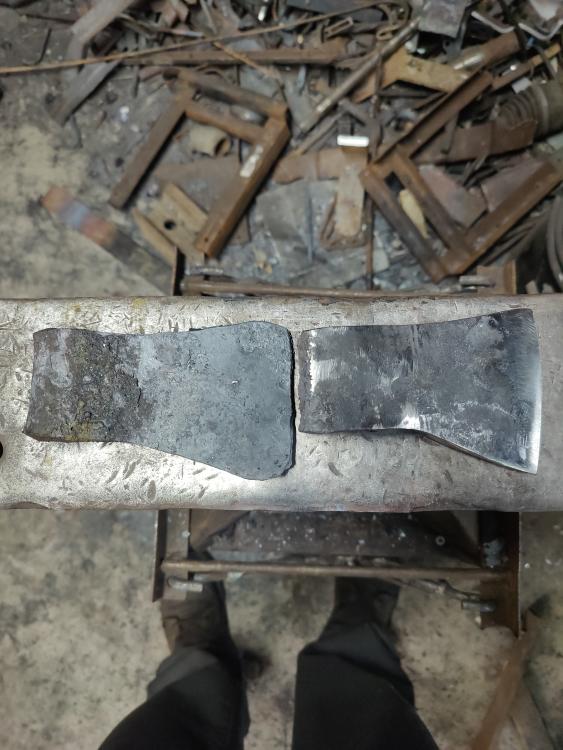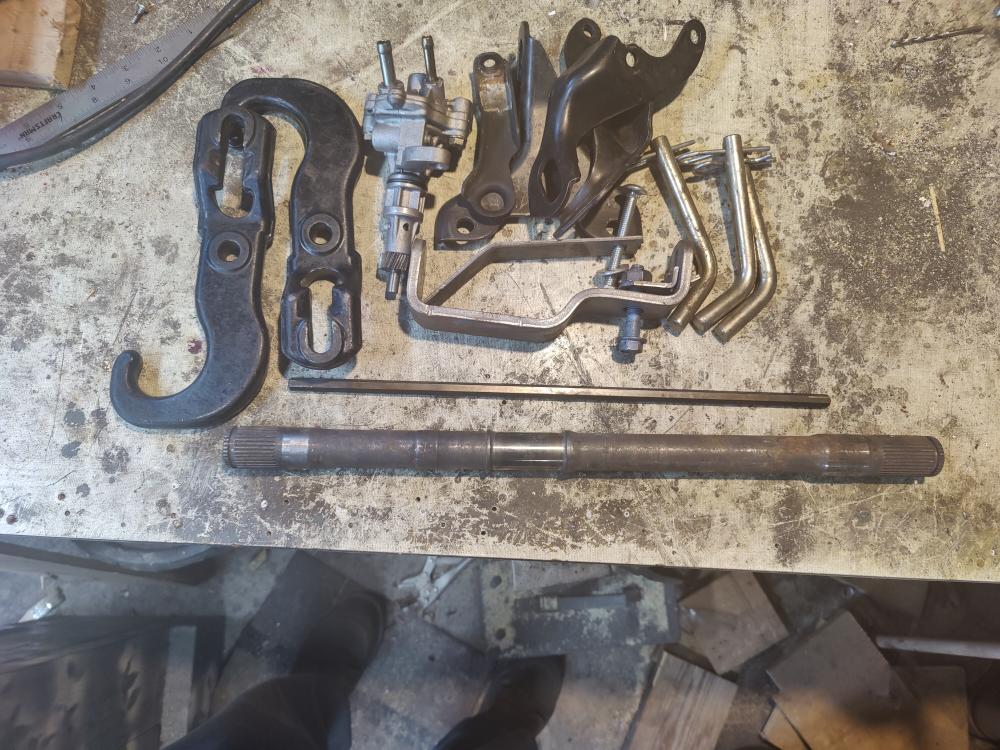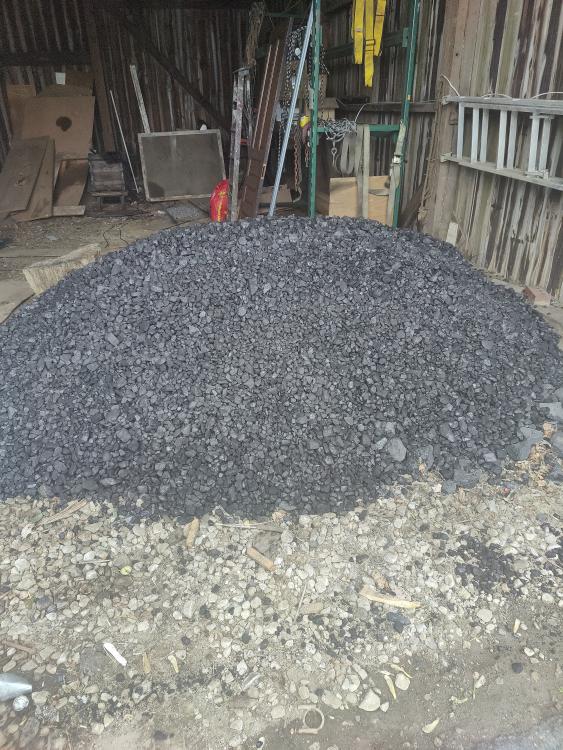-
Posts
2,493 -
Joined
-
Last visited
Content Type
Profiles
Forums
Articles
Gallery
Downloads
Events
Everything posted by BillyBones
-

What did you do in the shop today?
BillyBones replied to Mark Ling's topic in Blacksmithing, General Discussion
Like the gator. To bad you aint closer i got a whole spool of .030 laying on top the scrap pile from a welder i...uh...just did not get a long with that is now in the scrap pile also. -
The machines i run at work are called Davenport screw machines. Imagine a 5 spindle lathe that indexes to different cutting positions. But i hold tolerances within .0005". One of the machines has a 1906 build date. Proves that old tech is still good tech and if taken care of can last forever. Davenports are now all computer controlled CNC things that just need button pushers.
-
I have used auto feed drill presses before, i was just joking about who really uses it. Everyone i know does it by feel. My drill press is an old Cummins built in 1978. Works great need new belts though. I found a machine shop here that had a big 3 head drill press for sale. But the wife would have hurt me if i spent what they were asking.
-

What did you do in the shop today?
BillyBones replied to Mark Ling's topic in Blacksmithing, General Discussion
Well i burned my self. The web between my thumb and finger. Not a bad burn just a little red and puffy, but i thought ya'll might get a kick out of how. So i was drifting an ax eye open and of course the drift gets a little stuck. So i put him in the old vice give a few whacks to the back and the corners and the drift starts to loosen. So i whack the business end of the drift protruding from the eye and out she flies. With ninja like reflexes i managed to catch it in mid air...by the hot end. -

advice Cleaning intricate pieces.
BillyBones replied to mpc's topic in Blacksmithing, General Discussion
Yes you can sandblast with out a cabinet. You can buy a syphon blaster that an air hose pugs into the end and has a syphon hose you just stick in a bag of sand. Keep in mind that sand goes EVERYWHERE. You will find sand in places you never dreamed of for years to come. And definitely wear your PPE. Many mechanics have a sandblaster. Try calling your mechanic or body shop and ask if they have one and what it would take to blast it for you. -
Generally yes grind a coated drill and you have a HSS drill with coating on the secondary edges, sides. However they do make carbide and cobalt TiN coated drills. Those are found in specialty applications like aircraft manufacture. They also cost a pretty penny. 1030 is a pretty high carbon steel for what i do at my job. However i have cut much harder steels at home on my drill press but i do anneal the material first. So i cannot say yes it will cut it but i can say i have done it annealed. Keep in mind many of the cutting tools you are already using are made of HSS steel, taps, dies, files, etc. Most of the HSS steel you will encounter is of the M-2 or M-50 variety. Cutting steel is all about speed and feed. Anvil, what is this auto feed that you speak of? Frosty, i am like you, a hand drill is for shootin screws. I aint no good with one either.
-
Sharpening drills is easy peasy once you learn the "wrist flip". When i first started in a machine shop years ago i asked about sharpening the drills. An old guy pointed to the snag grinder, then proceded to teach me how to do it. The trick is to hold it at the proper angle then flip the wrist so that you cut the back side lower than the cutting edge. Easy to show, hard to explain. Also a good sharp stone on the grinder is required. Another note is relieve the back of the drill. Get that cutting edge as thin as possible. The relief will help chips get pulled out of the hole, and provide some room so they do not build up and get snagged. Many of the newer larger drills come from the factory with the back side relieved now but not the smaller ones. Cutting speed an pressure is dependent on what you are cutting and with what. A carbide drill cuts at a different speed than a HSS and stainless cuts with much more pressure than mild. The trick is to get enough pressure so you have a proper chip but not so much that you burn it up with to much pressure. Deeper cuts require multiple cuts also. Cut about 1/2" pull the drill, blow out the hole, drill and repeat. Never try and take a deep hole in a single cut. Heat is what make things hard to work. There is heat build up in 3 places. The tool, the piece you are working, and the chip. If your tool heats up it becomes soft and will not cut, if the piece heats up it work hardens and will not cut, what you want is to get the chip to carry the heat away from the tool and the piece you are working. That goes back to getting a proper chip for the material. Do not use to much oil. When hand drilling a couple drops is all that is needed. If it starts to dry out a couple more. Do not flood the area or fill the hole with oil. That will just waste the oil and the oil can bind the chips in the hole. I get cutting oil from work, a quart of oil is still about 1/2 full after a year. The oil does not have to be anything special either. Water can be used but evaporates fast. Just something to lube the hole and drill. Pilot holes are not necessary either. I have cut some pretty big hole and the only thing i ever do is maybe use a spot drill on big drills. Just enough to get it centered. A lot of new fangled drills are on the market now but a good quality set of old fashioned HSS twist drills will last you a lifetime if you keep them sharp and use them properly. The majority of the drills i have replaced is becuase i have lost them. There really is no need for the specialty drills in the home workshop. Even in the shop at work we mostly use HSS with the occasional carbide or coated drill. Getting into cutting materials other than steel (brass, aluminum, nylon, copper, etc.) is when we start getting into the specialty drills. Also a carbide or coated drill gives a different chip than HSS so you have to watch that. You can tell a lot about how your tooling is by how the chip looks. For instance a HSS drill cutting mild should make small chips if it starts pulling a spiral the drill is getting dull. That is a general rule of thumb. I posted this on another thread but think it is worth posting here. To get the speed and feed to cut is a simple formula. You do need some info to plug in though. RPM = (FPM x 12 / PI x dia. of tool) . FPM will change with material and tool. Those can be found from the tool manufacture and the material supplier or there are about a dozen books on the market with that info. (RPM x PI x tool dia. / 12) will give you FPM. For those who may not know: HSS is high speed steel and FPM is feet per minute.
-

What did you do in the shop today?
BillyBones replied to Mark Ling's topic in Blacksmithing, General Discussion
Minions, that is what minions are for. Got an order for a couple hatchets, a while back ago. Made these with some mild flat bar i found in the barn and a piece of old rasp for the bit. Been working A-36 for so long now i had nearly forgotten how nice plain mild works and welds. The one on the left is fresh out of the forge from welding, still needs some hammer time, the one on the right is about ground to shape and ready for heat treat. One day soon i need to get the shovel and skootch my scrap pile back before it over takes my anvil. -

My first Hot Cut Hardy tool
BillyBones replied to Bantou's topic in Hot Cuts, Anvil devils, metal cutting on the anvil.
Frosty, that pic reminds me of my granddad. -

Blacksmithing gems and pearls
BillyBones replied to Glenn's topic in Blacksmithing, General Discussion
No, just a tad late on the discussion. Did not realize that was almost a month ago. -

What did you do in the shop today?
BillyBones replied to Mark Ling's topic in Blacksmithing, General Discussion
My grandfather was doing a hot tar roof once when he fell off the roof. He landed with his arm from finger tip to elbow in a bucket of hot tar. Many skin grafts to get that fixed back up. When i was a kid i was aloud 1 pop a day. I always waited until evening after my bath to have it. That has carried over into adulthood and i still to this day have 1 pop a day, if i even have one. I am also not a big fan of the major pop brands like coke or pepsi, i like a good ginger ale or birch beer, love me a black cherry IBC, or a Cheer wine. -

Blacksmithing gems and pearls
BillyBones replied to Glenn's topic in Blacksmithing, General Discussion
I always though the first aid kit they gave me in the Army was funny. It consisted of 1 field dressing. I was the designated combat life saver in my platoon. That meant that i had a little more than basic first aid training, things such as how to give an IV. So my kit contained much more. Saline bags, IV tubing, needles and even morphine. The life saver part is a little misleading. Your job is actually just to make the person as comfortable as possible. Those store bought first aid kits are absolutely useless. Filled with a little guaze and a whole plethora of useless band-aids. I keep a first aid kit in my truck. I have found that a tackle box makes a good one. I do not keep pads but that is becuase i have a supply of field dressings, if i did not i would. Among things not mentioned i also keep needle and thread and an exacto knife set. Never know when you may have to stitch someone up or preform minor surgery. I modeled my kit after the one a guy i knew that was a survival instructor had. -

My first Hot Cut Hardy tool
BillyBones replied to Bantou's topic in Hot Cuts, Anvil devils, metal cutting on the anvil.
Your lucky, my dad between the time he got out of Vietnam and the time he re-enlisted, about 5 years or so, he had an afro, wore the polyester shirts with those big wide collars, bell bottoms and lamb chops. -

My first Hot Cut Hardy tool
BillyBones replied to Bantou's topic in Hot Cuts, Anvil devils, metal cutting on the anvil.
P-nut, i just imagined you with the rolled up cuffs, tucked in white t-shirt with a pack of cigarettes' rolled into the sleeve looking all James Dean or maybe Marlon Brando. -

My first Hot Cut Hardy tool
BillyBones replied to Bantou's topic in Hot Cuts, Anvil devils, metal cutting on the anvil.
Series of holes? Some of mine look like lace! Best thing i have found for a burn. When i first started smithing someone, and it may have been some one here, told me that as soon as you get burned, say your hand, stick it in the slack tub and keep it moving until the pain goes away. It works. Not real feasible though to stick half my leg in there, not only can i not lift it that high any more, i would have to get half naked. It would be cool to see the look on the neighbor if they saw me half naked with my leg in a barrel of water though. -

My first Hot Cut Hardy tool
BillyBones replied to Bantou's topic in Hot Cuts, Anvil devils, metal cutting on the anvil.
Scale can also set your britches on fire. I know this from the huge scar i have on my leg. It will also burn small holes in the bottom the legs, no big deal at the time except they are just at the right height to catch on the hooky things for my boot laces about a 1/2" higher than where they would be with the waist on my belt line. So it tugs down enough to be annoying and you have to give a little slack to get it undone and...oooo its frustrating. -
The pump is an internal gear pump. It has one small drive gear with a larger internal toothed ring gear running eccentric to the drive. like a Ford transmission pump. I believe what you would want is an external gear pump where it just has 2 gears squishing fluid between them. Honda transmissions do however use that style of pump.
-
Stopped by the tranny shop i used to work in to say hi and scored a few things. An out put shaft for a 4T65, a pump shaft for a CD4E, 5/16" hex, a couple brackets to hold torque convertors in during transport, pins, a hand full of engine lifting eyes, 2 big tow hooks, and a Honda power steering pump. The pump runs off of the speedometer gear in Honda transmissions, you can hook a drill up to the little shaft end and they make great fluid transfer pumps.
-

Can't forge weld - workpiece cooling too fast
BillyBones replied to CrazyOatmeal's topic in Blacksmithing, General Discussion
Put an anvil on or next to your forge. When i am trying to weld small stuff i set a block of 4140 that is about 15# on my forge. You do not have to hit it real hard to get the weld. You could even use a sledge hammer head to do it. I use a coal forge so i can just skootch some coal away for enough space. If you are using a gasser you may have to rig up some kind of table or something. Goods beat me to it. -
This is what i know about electricity: call an electrician. I have done some pretty crazy things in my life, i have been in some really dangerous situations, some i may should have not walked away from, but electricity scares the bejeebus outa me.
-

What did you do in the shop today?
BillyBones replied to Mark Ling's topic in Blacksmithing, General Discussion
Alexandr, i thought at first you had to clean the legs of the barstools in the restaurant, then i scrolled down. As always very nice work indeed. Snuffy, that is a right nice piece of work on that candle stick there also. -
Mail call ? 2.5 ton of stoker. Got the left overs from what they did not want at Carillon park's blacksmith shop. I am pretty stoked.
-

What did you do in the shop today?
BillyBones replied to Mark Ling's topic in Blacksmithing, General Discussion
IDF&C, we have a store here called "The Hardwood Store". That is all they carry is hard woods. He has a huge selection also from exotics to domestics. He will buy lumber from houses, barns, etc. being tore down like the tiger maple he had for a while. So some of it will have paint and the like. But a peice of walnut or hickory or something similar he gets from the mill. Paul, screw jack stands are also pretty commonly used by mechanics. When i was slinging transmissions i would put one under the rear diff of big trucks to steady them on a lift, or support an engine, whatever i needed it for. -
When i first started forging i was using a gasser that constited of 6 hard fire bricks in a metal frame. Not to heavy but i too had to tote it in and out of the basement along with propane tanks, hoses, etc. May not have been heavy but 4 or 5 trips up and down the stairs each time i wanted to fire it up became a real PITA. The wife didnot say anything about it, i was more worried somebody would want my tanks and tools more than i. So i had to do something. Can you put a small shed like thing in your back yard? I built one but my mom and dad bought one. A shed thing that is maybe 4' x 4' x 3'. The top is hinged and the front is 2 big doors that swing open. Fit my forge, on an old propane grill, 3 tanks 20#,
-

What did you do in the shop today?
BillyBones replied to Mark Ling's topic in Blacksmithing, General Discussion
I made a jig for doing collars. In one of Mark Asprey's videos on the lvl 4 grille he shows collaring the pieces and i copied his jig. Basically 2 pieces of angle iron that fit the vice with 2 smaller pieces welded on a bit from the edges. This provides a space to shape the collar while supporting the sides and bottom of it. He does make it, like everything else he does, look much easier than it actually is though.



